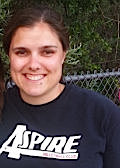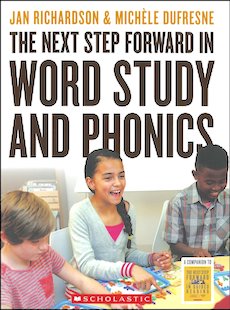The Next Step in Making Word Study a Breeze
The Next Step Forward in Word Study and Phonics
By Jan Richardson and Michéle Dufresne
(Scholastic, 2018 – Learn more)

Around thirty students sit in our classes each day, awaiting our guidance. These students come to us with a variety of backgrounds: some are English Learners, some have IEPs, and others just need some extra intervention when it comes to literacy.
No matter who is sitting in front of us, we’re always on the lookout for ways to best help this variety of learners. One such way we can help our learners is by using the wisdom found in The Next Step Forward in Word Study and Phonics, a companion to The Next Step Forward in Guided Reading, also by Jan Richardson.

The Assess-Decide-Guide Framework is present at the start of each chapter. Additionally, there are call-outs in each chapter about what to do when working with English learners at each level. This is especially valuable for teachers like me who find themselves with a range of ELs in each of my classes.
This book is very accessible with only seven chapters. And just like The Next Step Forward in Guided Reading, there are more resources than you know what to do with – a good problem to have! The resources come either in the appendices or via digital download at Scholastic.com, using the passcode found in the book. Digital resources include video clips and downloads of reproducibles.
Understanding the game plan: 5 minutes a day
The beginning of Chapter One lays out the framework for the book and the lessons to be found within. Richardson and Dufresne explain what can happen in a five-minute word study lesson, and what students should achieve with two days of guided reading lessons. They also explain the ways in which the word study lessons could be woven into a guided reading lesson, say from the RISE framework Richardson outlined in her previous book.
A page about working with English Learners is also present toward the end of the first chapter. There are many key points discussed that are either brand new tips for teachers of ELs or helpful reminders about how learners acquire new languages, especially English.
Word study activities and how to use them
Chapter Two covers a wide array of word study activities to suit the needs of any learner who might grace your classroom. Each activity is laid out with clear explanations of when to use it and how, as well as any materials that may be needed to have students engage with the activity. Another helpful categorization the authors provide is the reading level range for each activity.
For instance, if you want to teach a new sight word, you might be working with learners between levels A-I, and you might need dry-erase boards and markers to work through an activity. If you’re unsure of the reading level, you might search for an activity for your learner based on the skill they need to work on.
Let’s say they need work on sound blends; you might grab a box of picture cards for students to sort based on the sounds they hear when they say the word in the picture out loud. In all, there are ten word study activities outlined. Each is clearly explained, and there are video links throughout this chapter to clarify anything more visual learners might need to see.
Chapters target levels of readers
Chapters Three through Seven offer up lesson ideas for various levels of readers. If your learners are Pre-A, Chapter Three is for you! Emergent readers in levels A-C can be helped with lessons in Chapter Four, while Chapter Five has lessons for the Early Readers in levels D-I. Readers deemed Transitional Readers are in levels J-P and can study words using lessons in Chapter Six, and Fluent Readers in levels Q-Z can be aided with lessons in Chapter Seven.
As previously mentioned, each chapter reminds you to assess, decide, and guide students through their word study. Various assessment tools are provided, ideas for what the assessment might steer your decision toward, and lesson plan templates for you to ultimately guide your reader to master the skills they need.
Don’t forget about the videos! Every other page has a reminder to watch the video link. These provide so much context – either by teaching you how to do the activity, or by showing the authors working with groups of learners during a word study activity. The videos are a valuable addition to the book.
Flexible options throughout the book
I think if an educator were to balk at the idea of implementing these word study activities, it may be reassuring to remember that they are meant to take three to five minutes of the 20-minute guided reading lesson.
Something I’ve only recently realized is to start small. So I like the idea of picking a skill to focus on, doing a couple of lessons prescribed by this book, and then reflecting on how it went and where I can go from there.
The beauty of this book is that it is not a set curriculum. It is meant to provide some flexibility for how teachers implement the lessons. Remembering to take what you need for your students – and not be overwhelmed by every idea or resource that comes your way – is something I am having to remind myself about often, and something that seems applicable here.
This is a book for both novice teachers and seasoned veterans. There is an abundance of information here that will convince even the most skeptical that word study can be done quickly if done intentionally. The next step is to grab this book, plan some word study activities, and watch your students succeed!
Michelle Voelker is an 8th grade English and U.S. History teacher at a Title I school in Sacramento, CA. This past summer she was a fellow with Area 3 Writing Project in their Summer Institute and is now a teacher leader, providing workshops on writing in the history classroom. Before becoming a teacher, Michelle was an AmeriCorps member for a program that provided reading intervention on Title I elementary campuses. Since then, she has worked to make sure that every kid loves to read and can acquire the skills needed to become a lifelong reader.


































